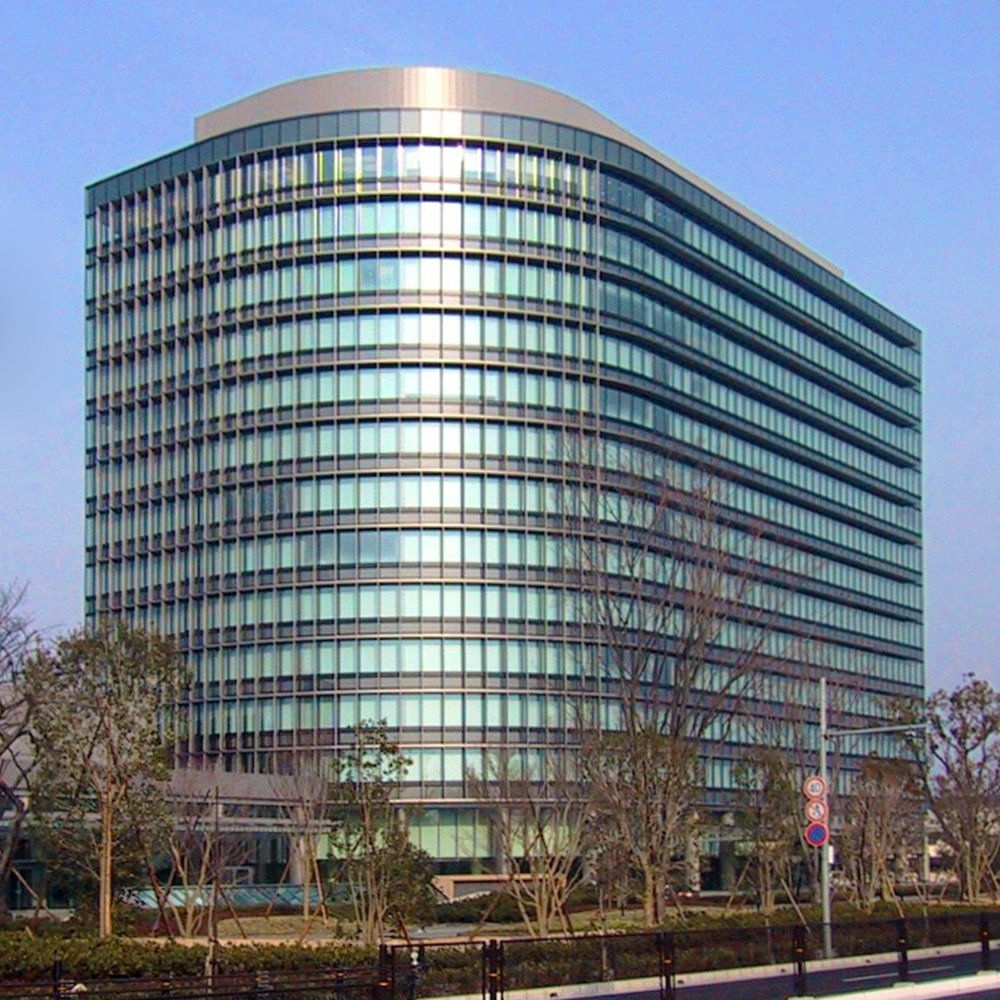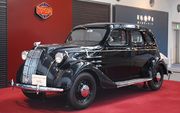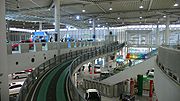History
Toyota started in 1933  as a division of Toyoda Automatic Loom Works devoted to the production of automobiles under the direction of the founder's son, Kiichiro Toyoda.[14] Its first vehicles were the A1 passenger car and the G1 in 1935. Toyota Motor Co. was established as an independent company in 1937.
as a division of Toyoda Automatic Loom Works devoted to the production of automobiles under the direction of the founder's son, Kiichiro Toyoda.[14] Its first vehicles were the A1 passenger car and the G1 in 1935. Toyota Motor Co. was established as an independent company in 1937.
Company overview


The Toyota Motor Company received its first Japanese Quality Control Award at the start of the 1980s and began participating in a wide variety of motorsports. Due to the 1973 oil crisis, consumers in the lucrative U.S. market began turning to small cars with better fuel economy. American car manufacturers had considered small economy cars to be an "entry level" product, and their small vehicles employed a low level of quality in order to keep the price low.
By the early sixties, the US had begun placing stiff import tariffs on certain vehicles. The Chicken tax of 1964 placed a 25% tax on imported commercials vans. In response to the tariff, Toyota, Nissan Motor Co. and Honda Motor Co. began building plants in the U.S. by the early eighties.
In 1982, the Toyota Motor Company and Toyota Motor Sales merged into one company, the Toyota Motor Corporation. Two years later, Toyota entered into a joint venture with GM called NUMMI, the New United Motor Manufacturing, Inc, operating an automobile-manufacturing plant in Fremont, California. The factory was an old General Motors plant that had been closed for two years. Toyota then started to establish new brands at the end of the 1980s, with the launch of their luxury division Lexus in 1989.
In the 1990s, Toyota began to branch out from producing mostly compact cars by adding many larger and more luxurious vehicles to its lineup, including a full-sized pickup, the T100 (and later the Tundra); several lines of SUVs; a sport version of the Camry, known as the Camry Solara; and the Scion brand, a group of several affordable, yet sporty, automobiles targeted specifically to young adults. Toyota also began production of the world's best-selling hybrid car, the Prius, in 1997.
With a major presence in Europe, due to the success of Toyota Team Europe, the corporation decided to set up TMME, Toyota Motor Europe Marketing & Engineering, to help market vehicles in the continent. Two years later, Toyota set up a base in the United Kingdom, TMUK, as the company's cars had become very popular among British drivers. Bases in Indiana, Virginia and Tianjin were also set up. In 1999, the company decided to list itself on the New York and London Stock Exchange.


In 2001, Toyota's Toyo Trust and Banking merged to form the UFJ, United Financials of Japan, which was accused of corruption by the Japan's government for making bad loans to alleged Yakuza crime syndicates with executives accused of blocking Financial Service Agency inspections. The UFJ was listed among Fortune Magazine's largest money-losing corporations in the world, with Toyota's chairman serving as a director. At the time, the UFJ was one of the largest shareholders of Toyota. As a result of Japan's banking crisis, the UFJ was merged again to become Mitsubishi UFJ Financial Group.
In 2002, Toyota managed to enter a Formula One works team and establish joint ventures with French motoring companies Citroën and Peugeot, a year after Toyota started producing cars in France.
Toyota ranked eighth on Forbes 2000 list of the world's leading companies for the year 2005. The company was number one in global automobile sales for the first quarter of 2008.
On December 7, 2004, a U.S. press release was issued stating that Toyota would be offering Sirius Satellite Radios. However, as late as January 27, 2007, Sirius Satellite Radio and XM Satellite radio kits were not available for Toyota factory radios.[citation needed] While the press release enumerated nine models, only limited availability existed at the dealer level in the U.S. As of 2008, all Toyota and Scion models have either standard or available XM radio kits. Major Lexus dealerships have been offering satellite radio kits for Lexus vehicles since 2005, in addition to factory-equipped satellite radio models.
In 2007, Toyota released an update of its full size truck, the Tundra, produced in two American factories, one in Texas and one in Indiana. "Motor Trend" named the Tundra "Truck of the Year," and the 2007 Toyota Camry "Car of the Year" for 2007. It also began the construction of two new factories, one to build the RAV4 in Woodstock, Ontario, Canada and the other to build the Toyota Prius in Blue Springs, Mississippi, USA. This plant was originally intended to build the Toyota Highlander, but Toyota decided to use the plant in Princeton, Indiana, USA instead. The company has also found recent success with its smaller models - the Corolla and Yaris - as gas prices have risen rapidly in the last few years.
Logo and Branding

In 1936, in anticipation for the launch for the Model AA, which was Toyota's first passenger car, Toyoda held a public competition to establish a new symbol mark to promote its vehicles. The company indicated that the new design should convey the feeling of speed. Twenty-seven thousand entrants answered the call and submitted their ideas to Toyoda. The winning design led to a change in the name of the automobiles and plants from "Toyoda" to "Toyota." The name change made the Japanese lettering more streamlined and was also chosen because the number of strokes to write Toyota in Japanese (eight) was thought to bring luck and prosperity. The sound of the word "Toyota" was also deemed more appealing. The Model AA was subsequently launched with the new logo. While the logo is no longer used on any product the mark is still used today as the corporate emblem of Toyota Motor Corporation and can be seen on their Headquarters in Aichi.
As the company expanded in the decades ahead, Toyota sought ways to consolidate the brand and raise international brand awareness. Although the mark "TOYOTA," in roman type, was in wide use, the lack of branding guidelines meant interpretation differed from country to country, resulting in an inconsistent global message.

Toyota's current logo used on its vehicles was introduced in 1989, to differentiate the Toyota brand from the newly launched Lexus brand. The Toyota Mark consists of three ovals: the two perpendicular center ovals represent a relationship of mutual trust between the customer and Toyota. These ovals combine to symbolize the letter "T" for Toyota. The space in the background implies a global expansion of Toyota's technology and unlimited potential for the future. The logo appears with the "TOYOTA" letter type that had been in use before.
The logo started appearing on all printed material, advertisements, and dealer signage starting in 1990 and on the cars themselves in 1991.


http: //tim. https://imgur.com/a/6CJQIpL https://imgur.com/a/xXk7zyr https://imgur.com/a/BfRVWA8 https://imgur.com/a/zcbvsPG https://imgur.com/a/I0w8l1X https://imgur.com/a/bgGYldE https://imgur.com/a/Ve8TQEZ
ReplyDelete